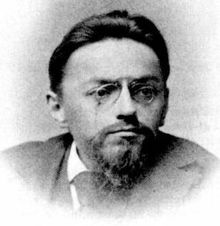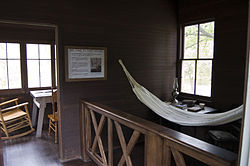- Charles Proteus Steinmetz
-
Charles Proteus Steinmetz 
Born Carl August Rudolph Steinmetz
April 9, 1865
Breslau, Province of Silesia, PrussiaDied October 26, 1923 (aged 58)
Schenectady, NY, USAOccupation Mathematician and electrical engineer Parents Carl Heinrich Steinmetz Charles Proteus Steinmetz (April 9, 1865 – October 26, 1923) was a German-American mathematician and electrical engineer. He fostered the development of alternating current that made possible the expansion of the electric power industry in the United States, formulating mathematical theories for engineers. He made ground-breaking discoveries in the understanding of hysteresis that enabled engineers to design better electric motors for use in industry.[1]
Contents
Early life
Steinmetz was born as Carl August Rudolph Steinmetz to Carl Heinrich Steinmetz in Breslau, Province of Silesia. Steinmetz suffered from dwarfism, hunchback, and hip dysplasia, as did his father and grandfather. Steinmetz attended Johannes Gymnasium and astonished his teachers with his proficiency in mathematics and physics.
Socialist activities
Following the Gymnasium Steinmetz went on to the University of Breslau to begin work on his undergraduate degree in 1883. He was on the verge of finishing his Doctorate in 1888 when he came under investigation by the German police for activities on behalf of a socialist university group and articles he had written for a local socialist newspaper.
As socialist meetings and press had been banned in Germany, Steinmetz fled to Zürich in 1888 to escape possible arrest. Faced with an expiring visa, he emigrated to the United States in 1889.
Cornell University Professor Ronald R. Kline, the author of Steinmetz: Engineer and Socialist, contends that other factors were more directly involved in Steinmetz's decision to leave his homeland, such as the fact that he was in arrears with his tuition at the University of Breslau and that life at home with his father, stepmother, and their daughters was full of tension.
Despite his earlier efforts and interest in socialism, by 1922 Steinmetz concluded that socialism would never work in the United States because the country lacked a "powerful, centralized government of competent men, remaining continuously in office" and because "only a small percentage of Americans accept this viewpoint today."[2]
Career in science
Shortly after arriving in the US, Steinmetz went to work for Rudolf Eickemeyer in Yonkers, New York, and published in the field of magnetic hysteresis. Eickemeyer's firm developed transformers for use in the transmission of electrical power among many other mechanical and electrical devices. In 1893 Eickemeyer's company, along with all of his patents and designs, was bought by the newly formed General Electric Company.
Forger of thunderbolts
One of Steinmetz's great research projects was centered with the phenomena of lightning. He undertook a systematic study of it, resulting in experiments of man-made lightning in the laboratory; this work was published. Steinmetz was called the "forger of thunderbolts", being the first to create artificial lightning in his GE football field-sized laboratory and high towers, using 120,000 volt generators. He erected a lightning tower to attract lightning and studied the patterns and effects of lightning hits on tree bark and in a broken mirror—resulting in several theories and ideas (like the effect of lightning on plant growth and ac electric poles).
Later years
Steinmetz served as president of the Board of Education of Schenectady, and as president of the Schenectady city council. He was president of the American Institute of Electrical Engineers (AIEE) from 1901 to 1902,[3] as well as the first vice-president of the International Association of Municipal Electricians (IAME)—which later became the International Municipal Signal Association (IMSA)—from 1913 until his death. Steinmetz wrote 13 books and 60 articles, not all about science. He was an honorary member and advisor to the fraternity Phi Gamma Delta at Union (whose chapter house there was one of the first electrified houses ever).
Steinmetz died on October 26, 1923 and was buried in Vale Cemetery, Schenectady.
Legacy
His connection to Union College is celebrated with the annual Steinmetz Symposium,[4] a day-long event in which Union undergraduates give presentations on research they have done. Steinmetz Hall, which houses the Union College computer center, is named after him.
Steinmetz was portrayed in 1959 by the actor Rod Steiger in the CBS anthology series, The Joseph Cotten Show. The episode centered on his socialist activities in Germany.
Patents
At the time of his death, Steinmetz held over 200 patents:[5]
- Steinmetz, U.S. Patent 533,244, "System of distribution by alternating current." January 29, 1895.
- Steinmetz, U.S. Patent 559,419, "Inductor dynamo."
- Steinmetz, U.S. Patent 583,950, "Three phase induction meter."
- Steinmetz, U.S. Patent 594,145, "Inductor dynamo."
- Steinmetz, U.S. Patent 714,412, "Induction motor."
- Steinmetz, U.S. Patent 717,464, "System of electrical distribution."
- Steinmetz, U.S. Patent 865,617, "Induction motor."
- Steinmetz, U.S. Patent 1,025,932, "Means for producing light." May 7, 1912.
- Steinmetz, U.S. Patent 1,042,986, "Induction furnace."
- Steinmetz, U.S. Patent 1,230,615, "Protective device."
- Steinmetz, U.S. Patent RE11,576, "Inductor dynamo."
In popular culture
Steinmetz is featured in John Dos Passos' USA Trilogy in one of the biographies.[6] He also serves as a major character in Starling Lawrence's The Lightning Keeper.[7]
His name is used several times during certain episodes of The Simpsons by industrialist Mr. Burns as an expletive ("Come on, Steinmetz, while we're still young!") whenever he feels people are taking longer than he would like.
Awards
- Certificate of Merit of The Franklin Institute (1908).
- Elliott Cresson Medal (1913).
- Cedergren Medal (1914).
Works
- Theory and calculation of alternating current phenomena", with the assistance of Ernst J. Berg, 1897. Information from this book has been reprinted in many subsequent engineering texts.
- The Natural Period of a Transmission Line and the Frequency of lightning Discharge Therefrom, The Electrical World, August 27, 1898. Pg. 203 - 205.
- Theoretical elements of electrical engineering, McGraw, 1902.
- Future of Electricity, Transcript of lecture to the New York Electrical Trade School, 1908.
- General lectures on electrical engineering, edited by Joseph Le Roy Hayden, Robson & Adee, 1908.
- Radiation, light and illumination : a series of engineering lectures delivered at Union college, ed. by Joseph Le Roy Hayden, McGraw-Hill, 1909
- Elementary lectures on electric discharges, waves and impulses, and other transients, 1911.
- Theory and calculation of transient electric phenomena and oscillations, McGraw publishing company, 1911.
- America and the new epoch, Harper, c. 1916.
- Engineering mathematics; a series of lectures delivered at Union College, 1917.
- Theory and calculation of electric apparatus, 1917.
- Essay on Science and Religion at Project Gutenberg. Homer Heath Nugent, 1922.
- Four lectures on relativity and space, McGraw-Hill book co. inc., 1923.
References
- ^ Invent Now | Hall of Fame | Search | Inventor Profile at www.invent.org
- ^ http://www.union.edu/N/DS/s.php?s=1512 Retrieved May-31-2009
- ^ "Charles Proteus Steinmetz". IEEE Global History Network. IEEE. http://www.ieeeghn.org/wiki/index.php/Charles_Proteus_Steinmetz. Retrieved 08 August 2011.
- ^ [1]
- ^ C. P. Steinmetz at www.becklaser.de
- ^ The 42nd Parallel, 335.
- ^ Smith, Dinitia (May 13, 2006). "Starling Lawrence Writes a Novel About the Early Days of G.E". The New York Times. http://www.nytimes.com/2006/05/13/books/13star.html?_r=1&pagewanted=print.
Note on the law of hysteresis. The Electrician. Jan 2. 1891 pp. 261–262.
Further reading
- Charles Proteus Steinmetz: A Biography, John Winthrop Hammond, New York Century Co., 1924.
- Steinmetz and his discoverer, John Thomas Broderick, 1924.
- Loki: The Life of Charles Proteus Steinmetz, Jonathan Norton Leonard, Doubleday, 1929.
- The Little Giant Of Schenectady, Dorothy Markey, Aladdin Books, 1936.
- Sigmund A Lavine (1955). Steinmetz, maker of lightning;. Dodd, Mead. http://www.amazon.com/gp/product/B0007DZOZ6., Sigmund Lavine, Dodd & Mead, 1955.
- Modern Jupiter, John Anderson Miller, American Society of Mechanical Engineers, 1958.
- Floyd Miller (1962). The electrical genius of Liberty Hall: Charles Proteus Steinmetz. McGraw-Hill. http://www.amazon.com/gp/product/B0006AY2UI. (aka The Man Who Tamed Lightning), Floyd Miller, McGraw-Hill, 1962.
- Steinmetz the Philosopher, Ernest Caldecott, Philip Alger, 1965.
- Charles Steinmetz: Scientist and Socialist (1865–1923) Including the complete Steinmetz-Lenin correspondence, Sender Garlin, American Institute for Marxist Studies, 1977 (reprinted in Sender Garlin's 1991 Three Radicals).
- Recollections of Steinmetz - A Visit to the Workshops of Dr. Charles Proteus Steinmetz,Emil J. Remscheid, General Electric Hall of History Foundation, 1977.
- Steinmetz in Schenectady - A Picture History of Three Memorable Decades, Larry Hart, Old Dorp Books, 1978.
- Steinmetz: Engineer and Socialist, Ronald Kline, Johns Hopkins University Press, 1998.
- Goodrich, Arthur (June 1904). "Charles P. Steinmetz, Electrician". The World's Work: A History of Our Time VIII: 4867–4869. http://books.google.com/books?id=AYbNAAAAMAAJ&pg=PA4867. Retrieved 2009-07-10.
External links
- Charles Proteus Steinmetz at Encyclopædia Britannica
- Union College Magazine Article November 1998.
- U.S. Supreme Court, "Steimetz v. Allen, 192 U.S. 543 (1904)". Steimetz v. Allen, Commissioner of Patents. No. 383. Argued January 12, 13, 1904. Decided February 23, 1904.
- Steinmetz Symposium at Union College
Categories:- 1865 births
- 1923 deaths
- American electrical engineers
- American inventors
- American people of German descent
- American scientists
- American socialists
- American Unitarians
- General Electric people
- German emigrants to the United States
- Members of the Socialist Party of America
- National Inventors Hall of Fame inductees
- People from Schenectady, New York
- People from the Province of Silesia
- People from Wrocław
- People with dwarfism
- Schenectady City Council members
- University of Breslau alumni
Wikimedia Foundation. 2010.



